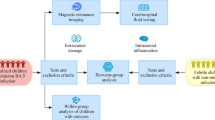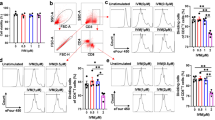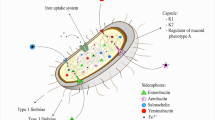Abstract
Streptococcus suis (S. suis) is an emerging zoonotic agent that can cause meningitis in humans with high mortality and morbidity. Meningitic S. suis can induce higher level of IL-17 than non-meningitic S. suis. Besides, IL-17A plays various roles on bacterial clearance or disruption of blood-CNS barriers through the downregulation and reorganization of tight junction (TJ) molecules. However, it remains to be elucidated for the role of IL-17A on the infection with meningitic S. suis. Here, we found that meningitic S. suis infection could not only cause acute death due to the damage of multiple organs, but also cause meningitis and clinical nervous signs since 60 h of post-infection due to the penetration of blood-CNS barriers after lasting bacteremia. In contrast, the mice with deficiency of il17a gene could not significantly change the acute inflammatory response and acute death, but it could not show obvious meningitis and clinical nervous signs caused by the meningitic S. suis infection. In addition, we also found that IL-17A could inhibit the transcription and expression of TJ proteins that facilitated the leakage of blood-CNS barriers since 60 h of post-infection during meningitic S. suis infection. Thus, our findings demonstrated that IL-17A could downregulate TJ proteins, which undoubtedly facilitated the leakage of blood-CNS barriers for bacterial invasion and then caused S. suis meningitis, providing potential targets for future prevention and treatment of this disease.




Similar content being viewed by others
Data Availability
Please contact the corresponding author upon reasonable request.
References
El Kareh A, El Hage S, Safi S, Assouad E, Mokled E, Salameh P (2020) Epidemiology of bacterial meningitis in Lebanon from 2011 to 2019. J Clin Neurosci 81:32–36. https://doi.org/10.1016/j.jocn.2020.09.011
Collaborators GBDM (2018) Global, regional, and national burden of meningitis, 1990-2016: a systematic analysis for the Global Burden of Disease Study 2016. Lancet Neurol 17:1061–1082. https://doi.org/10.1016/S1474-4422(18)30387-9
Zhao Z, Shang X, Chen Y, Zheng Y, Huang W, Jiang H, Lv Q, Kong D, Jiang Y, Liu P (2020) Bacteria elevate extracellular adenosine to exploit host signaling for blood-brain barrier disruption. Virulence 11:980–994. https://doi.org/10.1080/21505594.2020.1797352
Erdem H, Inan A, Guven E, Hargreaves S, Larsen L, Shehata G, Pernicova E, Khan E, Bastakova L, Namani S et al (2017) The burden and epidemiology of community-acquired central nervous system infections: a multinational study. Eur J Clin Microbiol Infect Dis 36:1595–1611. https://doi.org/10.1007/s10096-017-2973-0
van de Beek D, Brouwer M, Hasbun R, Koedel U, Whitney CG, Wijdicks E (2016) Community-acquired bacterial meningitis. Nat Rev Dis Primers 2:16074. https://doi.org/10.1038/nrdp.2016.74
Coureuil M, Lecuyer H, Bourdoulous S, Nassif X (2017) A journey into the brain: insight into how bacterial pathogens cross blood-brain barriers. Nat Rev Microbiol 15:149–159. https://doi.org/10.1038/nrmicro.2016.178
Segura M(2009) Streptococcus suis: an emerging human threat. J Infect Dis, 199:4-6.doi: 10.1086/594371
Mai NT, Hoa NT, Nga TV, Linh le D, Chau TT, Sinh DX, Phu NH, Chuong LV, Diep TS, Campbell J, et al(2008) Streptococcus suis meningitis in adults in Vietnam. Clin Infect Dis, 46:659-667.doi: 10.1086/527385
Kerdsin A, Gottschalk M, Hatrongjit R, Hamada S, Akeda Y, Oishi K (2016) Fatal septic meningitis in child caused by Streptococcus suis serotype 24. Emerg Infect Dis 22:1519–1520. https://doi.org/10.3201/eid2208.160452
van Samkar A, Brouwer MC, Schultsz C, van der Ende A, van de Beek D (2015) Streptococcus suis meningitis: a systematic review and meta-analysis. PLoS Negl Trop Dis, 9:e0004191.doi: 10.1371/journal.pntd.0004191
Dominguez-Punaro MD, Segura M, Contreras I, Lachance C, Houde M, Lecours MP, Olivier M, Gottschalk M (2010) In vitro characterization of the microglial inflammatory response to Streptococcus suis, an important emerging zoonotic agent of meningitis. Infect Immun 78:5074–5085
Disson O, Lecuit M (2012) Targeting of the central nervous system by Listeria monocytogenes. Virulence 3:213–221. https://doi.org/10.4161/viru.19586
McGill F, Heyderman RS, Panagiotou S, Tunkel AR, Solomon T (2016) Acute bacterial meningitis in adults. Lancet 388:3036–3047. https://doi.org/10.1016/S0140-6736(16)30654-7
Kim KS (2008) Mechanisms of microbial traversal of the blood-brain barrier. Nat Rev Microbiol 6:625–634. https://doi.org/10.1038/nrmicro1952
Doran KS, Fulde M, Gratz N, Kim BJ, Nau R, Prasadarao N, Schubert-Unkmeir A, Tuomanen EI, Valentin-Weigand P (2016) Host-pathogen interactions in bacterial meningitis. Acta Neuropathol 131:185–209. https://doi.org/10.1007/s00401-015-1531-z
Takeuchi D, Akeda Y, Nakayama T, Kerdsin A, Sano Y, Kanda T, Hamada S, Dejsirilert S, Oishi K (2014) The contribution of suilysin to the pathogenesis of Streptococcus suis meningitis. J Infect Dis 209:1509–1519. https://doi.org/10.1093/infdis/jit661
Lv Q, Hao H, Bi L, Zheng Y, Zhou X, Jiang Y (2014) Suilysin remodels the cytoskeletons of human brain microvascular endothelial cells by activating RhoA and Rac1 GTPase. Protein Cell 5:261–264. https://doi.org/10.1007/s13238-014-0037-0
Rui L, Weiyi L, Yu M, Hong Z, Jiao Y, Zhe M, Hongjie F (2018) The serine/threonine protein kinase of Streptococcus suis serotype 2 affects the ability of the pathogen to penetrate the blood-brain barrier. Cell Microbiol:e12862. https://doi.org/10.1111/cmi.12862
Jobin MC, Gottschalk M, Grenier D (2006) Upregulation of prostaglandin E2 and matrix metalloproteinase 9 production by human macrophage-like cells: synergistic effect of capsular material and cell wall from Streptococcus suis. Microb Pathog 40:29–34. https://doi.org/10.1016/j.micpath.2005.10.003
Tenenbaum T, Matalon D, Adam R, Seibt A, Wewer C, Schwerk C, Galla HJ, Schroten H (2008) Dexamethasone prevents alteration of tight junction-associated proteins and barrier function in porcine choroid plexus epithelial cells after infection with Streptococcus suis in vitro. Brain Res 1229:1–17. https://doi.org/10.1016/j.brainres.2008.06.118
Dominguez-Punaro MC, Segura M, Plante MM, Lacouture S, Rivest S, Gottschalk M(2007) Streptococcus suis Serotype 2, an important swine and human pathogen, induces strong systemic and cerebral inflammatory responses in a mouse model of infection. The Journal of Immunology, 179:1842-1854.doi: 10.4049/jimmunol.179.3.1842
Gottschalk M, Xu J, Calzas C, Segura M(2010) Streptococcus suis: a new emerging or an old neglected zoonotic pathogen? Future Microbiol, 5:371-391
Liu HT, Zhu S, Sun YY, Li N, Gu JM, Sun CJ, Feng X, Han WY, Jiang JX, Lei LC (2017) Selection of potential virulence factors contributing to Streptococcus suis serotype 2 penetration into the blood-brain barrier in an in vitro co-culture model. Journal of Microbiology and Biotechnology 27:161–170
Vanier G, Fittipaldi N, Slater JD, Dominguez-Punaro Mde L, Rycroft AN, Segura M, Maskell DJ, Gottschalk M (2009) New putative virulence factors of Streptococcus suis involved in invasion of porcine brain microvascular endothelial cells. Microb Pathog 46:13–20
Wang J, Kong D, Zhang S, Jiang H, Zheng Y, Zang Y, Hao H, Jiang Y (2015) Interaction of fibrinogen and muramidase-released protein promotes the development of Streptococcus suis meningitis. Front Microbiol 6:1001. https://doi.org/10.3389/fmicb.2015.01001
Yang XP, Fu JY, Yang RC, Liu WT, Zhang T, Yang B, Miao L, Dou BB, Tan C, Chen HC, Wang XR (2016) EGFR transactivation contributes to neuroinflammation in Streptococcus suis meningitis. J Neuroinflammation, 13:274.doi: 10.1186/s12974-016-0734-0
Rungelrath V, Weisse C, Schutze N, Muller U, Meurer M, Rohde M, Seele J, Valentin-Weigand P, Kirschfink M, Beineke A, et al(2018) IgM cleavage by Streptococcus suis reduces IgM bound to the bacterial surface and is a novel complement evasion mechanism. Virulence, 9:1314-1337.doi: 10.1080/21505594.2018.1496778
Sun Y, Li N, Zhang J, Liu H, Liu J, Xia X, Sun C, Feng X, Gu J, Du C et al (2016) Enolase of Streptococcus Suis serotype 2 enhances blood-brain barrier permeability by inducing IL-8 release. Inflammation 39:718–726. https://doi.org/10.1007/s10753-015-0298-7
Seele J, Tauber SC, Bunkowski S, Baums CG, Valentin-Weigand P, de Buhr N, Beineke A, Iliev AI, Bruck W, Nau R (2018) The inflammatory response and neuronal injury in Streptococcus suis meningitis. BMC Infect Dis 18:297. https://doi.org/10.1186/s12879-018-3206-6
OuYang X, Guo J, Lv Q, Jiang H, Zheng Y, Liu P, Zhao T, Kong D, Hao H, Jiang Y (2020) TRIM32 drives pathogenesis in streptococcal toxic shock-like syndrome and Streptococcus suis meningitis by regulating innate immune responses. Infect Immun 88. https://doi.org/10.1128/IAI.00957-19
Lin L, Xu L, Lv W, Han L, Xiang Y, Fu L, Jin M, Zhou R, Chen H, Zhang A (2019) An NLRP3 inflammasome-triggered cytokine storm contributes to Streptococcal toxic shock-like syndrome (STSLS). PLoS Pathog 15:e1007795. https://doi.org/10.1371/journal.ppat.1007795
Xu L, Lin L, Lu X, Xiao P, Liu R, Wu M, Jin M, Zhang A (2021) Acquiring high expression of suilysin enable non-epidemic Streptococcus suis to cause Streptococcal toxic shock-like syndrome (STSLS) through NLRP3 inflammasome hyperactivation. Emerg Microbes Infect:1–26. https://doi.org/10.1080/22221751.2021.1908098
Sun Y, Liu H, Du R, Li S, Qu G, Zhu R, Zhao S, Gu J, Sun C, Feng X et al (2018) Characteristic comparison of meningitis and non-meningitis of Streptococcus suis in an experimentally infected porcine model. Inflammation 41:368–377. https://doi.org/10.1007/s10753-017-0692-4
Chen K, Eddens T, Trevejo-Nunez G, Way EE, Elsegeiny W, Ricks DM, Garg AV, Erb CJ, Bo MH, Wang T et al (2016) IL-17 receptor signaling in the lung epithelium is required for mucosal chemokine gradients and pulmonary host defense against K. pneumoniae. Cell Host & Microbe 20:596–605. https://doi.org/10.1016/j.chom.2016.10.003
Cho JS, Pietras EM, Garcia NC, Ramos RI, Farzam DM, Monroe HR, Magorien JE, Blauvelt A, Kolls JK, Cheung AL et al (2010) IL-17 is essential for host defense against cutaneous Staphylococcus aureus infection in mice. Journal of Clinical Investigation 120:1762–1773. https://doi.org/10.1172/Jci40891
Isailovic N, Daigo K, Mantovani A, Selmi C (2015) Interleukin-17 and innate immunity in infections and chronic inflammation. J Autoimmun 60:1–11. https://doi.org/10.1016/j.jaut.2015.04.006
Conti HR, Bruno VM, Childs EE, Daugherty S, Hunter JP, Mengesha BG, Saevig DL, Hendricks MR, Coleman BM, Brane L et al (2016) IL-17 receptor signaling in oral epithelial cells is critical for protection against oropharyngeal candidiasis. Cell Host & Microbe 20:606–617. https://doi.org/10.1016/j.chom.2016.10.001
Dungan LS, Mills KH (2011) Caspase-1-processed IL-1 family cytokines play a vital role in driving innate IL-17. Cytokine 56:126–132. https://doi.org/10.1016/j.cyto.2011.07.007
Waisman A, Hauptmann J, Regen T (2015) The role of IL-17 in CNS diseases. Acta Neuropathol 129:625–637. https://doi.org/10.1007/s00401-015-1402-7
Huppert J, Closhen D, Croxford A, White R, Kulig P, Pietrowski E, Bechmann I, Becher B, Luhmann HJ, Waisman A, Kuhlmann CRW (2010) Cellular mechanisms of IL-17-induced blood-brain barrier disruption. Faseb Journal 24:1023–1034
Asano T, Ichiki K, Koizumi S, Kaizu K, Hatori T, Fujino O, Mashiko K, Sakamoto Y, Miyasho T, Fukunaga Y (2010) IL-17 is elevated in cerebrospinal fluids in bacterial meningitis in children. Cytokine 51:101–106. https://doi.org/10.1016/j.cyto.2010.03.001
Chen T, Wang C, Hu L, Lu H, Song F, Zhang A, Wang X, Chen H, Tan C (2021) Evaluation of the immunoprotective effects of IF-2 GTPase and SSU05-1022 as a candidate for a Streptococcus suis subunit vaccine. Future Microbiol 16:721–729. https://doi.org/10.2217/fmb-2020-0232
Ren H, Hua Z, Meng J, Molenaar A, Bi Y, Cheng N, Zheng X (2019) Generation of Acsl4 gene knockout mouse model by CRISPR/Cas9-mediated genome engineering. Crit Rev Biomed Eng 47:419–426. https://doi.org/10.1615/CritRevBiomedEng.2019030342
Engelen-Lee JY, Brouwer MC, Aronica E, van de Beek D (2016) Pneumococcal meningitis: clinical-pathological correlations (MeninGene-Path). Acta Neuropathol Commun 4:26. https://doi.org/10.1186/s40478-016-0297-4
Yang R, Liu W, Miao L, Yang X, Fu J, Dou B, Cai A, Zong X, Tan C, Chen H, Wang X (2016) Induction of VEGFA and Snail-1 by meningitic Escherichia coli mediates disruption of the blood-brain barrier. Oncotarget 7:63839–63855. https://doi.org/10.18632/oncotarget.11696
Sa JK, Chang N, Lee HW, Cho HJ, Ceccarelli M, Cerulo L, Yin J, Kim SS, Caruso FP, Lee M et al (2020) Transcriptional regulatory networks of tumor-associated macrophages that drive malignancy in mesenchymal glioblastoma. Genome Biol 21:216. https://doi.org/10.1186/s13059-020-02140-x
Zhang M, Mao Y, Ramirez SH, Tuma RF, Chabrashvili T (2010) Angiotensin II induced cerebral microvascular inflammation and increased blood-brain barrier permeability via oxidative stress. Neuroscience 171:852–858. https://doi.org/10.1016/j.neuroscience.2010.09.029
Ni C, Gao S, Zheng Y, Liu P, Zhai Y, Huang W, Jiang H, Lv Q, Kong D, Jiang Y (2021) Annexin A1 attenuates neutrophil migration and IL-6 expression through Fpr2 in a mouse model of Streptococcus suis-induced meningitis. Infect Immun 89. https://doi.org/10.1128/IAI.00680-20
Kumar H, Jo MJ, Choi H, Muttigi MS, Shon S, Kim BJ, Lee SH, Han IB (2018) Matrix metalloproteinase-8 inhibition prevents disruption of blood-spinal cord barrier and attenuates inflammation in rat model of spinal cord injury. Mol Neurobiol 55:2577–2590. https://doi.org/10.1007/s12035-017-0509-3
Al-Obaidi MMJ, Desa MNM (2018) Mechanisms of blood brain barrier disruption by different types of bacteria, and bacterial-host interactions facilitate the bacterial pathogen invading the brain. Cell Mol Neurobiol 38:1349–1368. https://doi.org/10.1007/s10571-018-0609-2
Goyette-Desjardins G, Auger JP, Xu J, Segura M, Gottschalk M(2014) Streptococcus suis, an important pig pathogen and emerging zoonotic agent-an update on the worldwide distribution based on serotyping and sequence typing. Emerging Microbes & Infections, 3:e45
Dutkiewicz J, Sroka J, Zajac V, Wasinski B, Cisak E, Sawczyn A, Kloc A, Wojcik-Fatla A (2017) Streptococcus suis: a re-emerging pathogen associated with occupational exposure to pigs or pork products. Part I - Epidemiology. Ann Agric Environ Med, 24:683-695.doi: 10.26444/aaem/79813
Fong IW (2017) Zoonotic Streptococci: a focus on Streptococcus suis. In Emerging Zoonoses: A Worldwide Perspective. Cham: Springer International Publishing: 189-21010.1007/978-3-319-50890-0_10
Hohnstein FS, Meurer M, de Buhr N, von Kockritz-Blickwede M, Baums CG, Alber G, Schutze N (2020) Analysis of porcine pro- and anti-inflammatory cytokine induction by S. suis in vivo and in vitro. Pathogens 9. https://doi.org/10.3390/pathogens9010040
Dutkiewicz J, Zajac V, Sroka J, Wasinski B, Cisak E, Sawczyn A, Kloc A, Wojcik-Fatla A(2018) Streptococcus suis: a re-emerging pathogen associated with occupational exposure to pigs or pork products. Part II - Pathogenesis. Ann Agric Environ Med, 25:186-203.doi: 10.26444/aaem/85651
Wewer C, Seibt A, Wolburg H, Greune L, Schmidt MA, Berger J, Galla HJ, Quitsch U, Schwerk C, Schroten H, Tenenbaum T (2011) Transcellular migration of neutrophil granulocytes through the blood-cerebrospinal fluid barrier after infection with Streptococcus suis. J Neuroinflammation 8:51. https://doi.org/10.1186/1742-2094-8-51
Xu L, Lu X, Xiao P, Liu R, Xia KL, Wu MZ, Jin ML, Zhang AD (2021) Interleukin-17A contributes to bacterial clearance in a mouse model of streptococcal toxic shock-like syndrome. Pathogens 10. https://doi.org/10.3390/pathogens10060766
Ge Y, Huang M, Yao YM (2020) Biology of Interleukin-17 and its pathophysiological significance in sepsis. Front Immunol 11:1558. https://doi.org/10.3389/fimmu.2020.01558
Acknowledgements
We would like to express our gratitude to Xiang Liu (NIH, USA) for help on discussion of the results.
Funding
This work was supported by the National Natural Science Foundation of China (31772714 and 31972649).
Author information
Authors and Affiliations
Contributions
LX and XL performed the experiments and analyzed the data, AZ and LX drafted the manuscript. PX, RL, and KX helped to analyze the data and revise the manuscript. AZ, MW, and MJ provided the material and technological support. AZ conceived the experiments and revised the manuscript. All authors read and approved the final manuscript.
Corresponding author
Ethics declarations
Ethics Approval and Consent to Participate
All procedures performed in studies involving animals were in accordance with the Scientific Ethics Committee of Huazhong Agricultural University (Permit Number: HZAUMO-2019-048). Consent to participate is not applicable.
Consent for Publication
Not applicable.
Conflict of Interest
The authors declare no competing interests.
Additional information
Publisher’s Note
Springer Nature remains neutral with regard to jurisdictional claims in published maps and institutional affiliations.
Supplementary Information
ESM 1
Table S1. Quality test results of brain tissue RNA. (XLSX 10 kb)
ESM 2
Fig. S1. Confirmation of il17a-/- mice. a DNA sequencing of the il17a gene in the il17a-/- and il17a+/+ mice. A 23bp DNA sequence was deleted in the il17a-/- mice. b Genotyping by PCR. A 390bp DNA fragment for KO and HET. A 405bp DNA fragment for WT and HET. (TIF 3894 kb)
ESM 3
Fig. S2. Histopathological scores in the brains. Histopathological scores of brain sections from wild type mice at 60h post-infection with meningitic S. suis (n=3). Error bars represented the mean ± standard deviations. (TIF 1425 kb)
ESM 4
Fig. S3. Flow cytometric analysis of Neutrophils isolated from mice blood post-infection. The il17a-/- and il17a+/+ mice were intraperitoneally infected with meningitic S. suis strain S29 or PBS. At the indicated time points, Samples of peripheral blood (0.2 ml) were collected from tail vein and then stained with phycoerythrin (PE) anti-mouse Ly6G and Fluorescein isothiocyanate (FITC) anti-mouse/human CD11b for flow cytometric analysis. Error bars represent the mean ± standard deviations. (TIF 2167 kb)
ESM 5
Fig. S4. Immunofluorescence results of isotype antibody of ZO-1 in brain. The brain of a wild type mouse was analyzed for isotype antibody of ZO-1 via immunofluorescence to exclude unspecific signals. (TIF 3283 kb)
Rights and permissions
About this article
Cite this article
Xu, L., Lu, X., Xiao, P. et al. Interleukin-17A Contributed to the Damage of Blood-CNS Barriers During Streptococcus suis Meningitis. Mol Neurobiol 59, 2116–2128 (2022). https://doi.org/10.1007/s12035-022-02749-y
Received:
Accepted:
Published:
Issue Date:
DOI: https://doi.org/10.1007/s12035-022-02749-y




